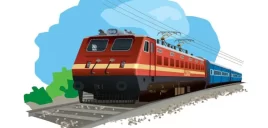Inaugurated on Jan. 26, 1950, CLW produced its first locomotive by Nov. 1, 1950 (a WG loco, #8401, named ‘Deshbandhu’ for Deshbandhu Chittaranjan Das, an Indian freedom-fighter; incidentally it was his widow, Basanti Devi, who inaugurated the works). CLW, originally named just the Locomotive Manufacturing Works, was located near a village called Mihijam, which was shortly afterwards renamed Chittaranjan. It is said that originally the locomotive works, which were under planning even in the mid-1940s, were to be set up at Kalyani near Howrah, but a concern about losing such a strategic asset in the foreseen partition of British India resulted in the shift to Chittaranjan, on the border of West Bengal and Bihar (Chittaranjan railway station is in Bihar).
ये भी पढ़े – इंडिया की इन खतरनाक और रहस्यमयी जगहों पर जाकर लें अलग एडवेंचर का अहसास
CLW became a major producer of steam locomotives, producing a large number of BG and MG steam locomotives through 1972 (total count – 2351). The last BG steam loco made in India, a WG (#10560, ‘Antim Sitara’ (‘The Last Star’) was delivered by CLW on June 30, 1970, and the last steam loco made in India was the MG YG classloco (#3573), delivered on Feb. 5, 1972.
CLW started early on the manufacture of electric locos, building the WCM-5 series DC locos starting in 1961. The first one was named ‘Lokamanya’, and delivered on Oct. 14, 1961. A few years later it began production of AC electric locos, starting with ‘Bidhan’, a WAG-1 class loco delivered on Nov. 16, 1963, which was also notable as the first fully Indian-built electric locomotive. Since then CLW has manufactured ever more sophisticated generations of electric locomotives, most recently delivering the advanced WAP-5 and WAP-7 3-phase AC locomotives. It has a capacity of around 200 or so electric locomotives a year.
CLW has also manufactured many diesel locos, mainly diesel-hydraulic shunters such as the WDS-4 class (begun in 1967-1968, although large numbers were produced only in 1969). In the ’70s and ’80s it built some diesels in the ZDM series and some YDM-2 units (diesel-electrics). Total diesel loco count – over 660 BG diesel shunters, over 140 NG diesels, and over 40 BG mainline diesels.
Diesel Loco Works, Varanasi
DLW was set up in 1961 and rolled out its first locomotive on Jan. 3., 1964 – a WDM-2, assembled from an Alco kit. It has evolved into an integrated diesel locomotive manufacturing plant, capable of building all components of the locomotives in-house, including the engines, superstructures, fabricated bogies, and underframes.
With technology transfer arrangements from manufacturers such as GM-EMD, DLW today produces advanced diesels with high efficiency and low maintenance costs. DLW has supplied a large variety of diesel locomotives (mostly diesel-electrics) to IR and numerous public-sector concerns (steel plants, power plants, ports, etc.). DLW has also exported locomotives to other countries such as Tanzania, Vietnam, Sri Lanka, Bangladesh, and Malaysia. Recently [2004] it has also got orders for 1350hp Cape gauge locos for Sudan (3), 1350hp MG locos for Myanmar (11), 2300hp Cape gauge locos for Angola (6), etc. It has also branched out into manufacturing non-railway items such as 2.4MW diesel generator sets (based on the Alco 251 engine!) to offset a recent decline in orders from IR. (Although, simultaneously, it has helped DMW (see below) and Parel Workshops (see below) to gain expertise in assembling locomotives as it hasn’t been able to keep up with the demand for some classes of locos, especially industrial shunters.) DLW’s production capacity is around 240 locomotives a year.
Source – IFRCA.org
This entry was posted in 2 Railway Employee, Railway General Information, Railway Employee











